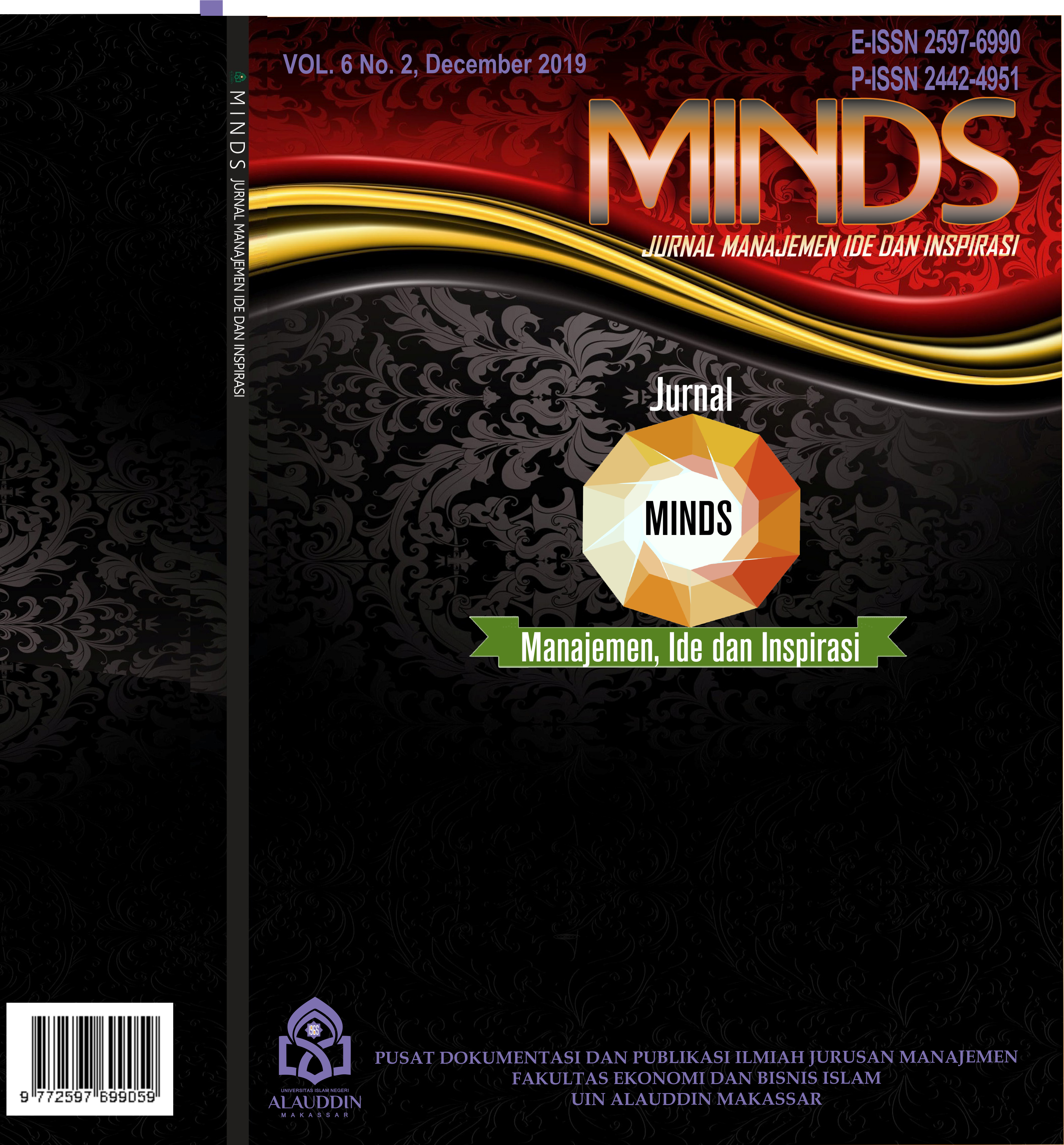Date Log
Copyright (c) 2020 Amir Hamzah

This work is licensed under a Creative Commons Attribution 4.0 International License.
Financial Inclusion Model on the Development of Batik SMEs in Cirebon Regency
Corresponding Author(s) : Amir Hamzah
Jurnal Minds: Manajemen Ide dan Inspirasi,
Vol. 7 No. 2 (2020): December
Abstract
This study aims to analyze the financial inclusion model on Batik SMEs' development in Cirebon Regency. Six constructs emerge as the objects of interest are financial literacy, financial technology, social capital, capital structure decisions, financial inclusion, and business development. 176 Batik-Cirebon artisans fill the questionnaires under the non-probability sampling technique and are analyzed using CB-SEM. The results prove that financial literacy, financial technology, social capital, capital structure decisions have a positive effect on financial inclusion, and financial inclusion positively affects business development Batik SMEs In Cirebon Regency.
Keywords
Download Citation
Endnote/Zotero/Mendeley (RIS)BibTeX
References
Azhari, F., Mawardi, M. K., Administrasi, F. I., & Brawijaya, U. (2018). Peran Modal Sosial Dalam Pengembangan Jaringan Usaha Kecil Menengah ( Studi Kasus pada Rumah Makan Padang ). 59(1), 153–162.
Bartlet, W., Đulić, K., & Kmezić, S. (2020). The impact of fiscal decentralisation on local economic development in Serbia. Lex Localis. https://doi.org/10.4335/18.1.143-163(2020)
Bongomin, G. O. C., Mpeera Ntayi, J., & C. Munene, J. (2017). Institutional framing and financial inclusion. International Journal of Social Economics. https://doi.org/10.1108/ijse-02-2015-0032
Delyana Rahmawany Pulungan, A. N. (2019). “Pengaruh Literasi Keuangan dan Modal Sosial Terhadap Inklusi Keuangan Mahasiswa.” SAMBIS, 132–142.
Fathy, R. (2019). Modal Sosial : KOnsep, Inklusivitas dan Pemberdayaan Masyarakat. Pemikiran, Jurnal Volume, Sosiologi, 6(1), 1–17.
Fisher, G., Kuratko, D. F., Bloodgood, J. M., & Hornsby, J. S. (2017). Erratum: “Legitimate to whom? The challenge of audience diversity and new venture legitimacy” (Journal of Business Venturing (2017) 32 (52–71)(S0883902616302087)(10.1016/j.jbusvent.2016.10.005)). In Journal of Business Venturing (Vol. 32, Issue 1, pp. 128–129). https://doi.org/10.1016/j.jbusvent.2016.11.003
Hamzah, A., & Suhardi, D. D. (2019). Tingkat Literasi Keuangan Dan Financial Technology Pada Pelaku Usaha Mikro, Kecil, Dan Menengah (UMKM) Kabupaten Kuningan. Jurnal Ilmiah Manajemen Fakultas Ekonomi), 5(2), 97–108.
Hanson, T. A., & Olson, P. M. (2018). Financial literacy and family communication patterns. Journal of Behavioral and Experimental Finance. https://doi.org/10.1016/j.jbef.2018.05.001
Hirdinis, M. (2019). Capital structure and firm size on firm value moderated by profitability. International Journal of Economics and Business Administration. https://doi.org/10.35808/ijeba/204
Hovakimian, A., Opler, T., & Titman, S. (2001). The Debt-Equity Choice. The Journal of Financial and Quantitative Analysis, 36(1), 1. https://doi.org/10.2307/2676195
Huston, S. J. (2010). Measuring Financial Literacy.
Iko Putri Yanti, W. (2019). Pengaruh Inklusi Keuangan Dan Literasi Keuangan Terhadap Kinerja Umkm Di Kecamatan Moyo Utara. Jurnal Manajemen Dan Bisnis, 2(1). https://doi.org/10.37673/jmb.v2i1.305
Lia Muhibatul Aliyah, N. (2019). Pengaruh Layanan Keuangan Berbasis Teknologi ( Fintech ) terhadap Literasi Keuangan Masyarakat Dago Atas , Bandung. Prosiding Manajemen, 5(1), 649–656.
Moenjak, T., Kongprajya, A., & Monchaitrakul, C. (2020). AND BORROWING : THE CASE Asian Development Bank Institute (Issue 1100).
Pambudianti, F. F. R., Purwanto, B., & Maulana, T. N. A. (2020). The implementation of fintech: Efficiency of MSMEs loans distribution and users’ financial inclusion index. Jurnal Keuangan Dan Perbankan, 24(1), 68–82. https://doi.org/10.26905/jkdp.v24i1.3218
Said, S., Amiruddin, A. M. A., Asad, A., Rustan, C., & Sofyan, A. S. (2019). Managing with Sharia: Strengthening Sharia Banking Spiritual Literation. Jurnal Minds: Manajemen Ide Dan Inspirasi, 6(2), 161. https://doi.org/10.24252/minds.v6i2.10297
Saputra, R. S., & Dewi, A. S. (2017). Peran Modal Sosial Sebagai Mediator Literasi Keuangan Dan Inklusi Keuangan Pada Kaum Muda Di Indonesia ( Studi Kasus Pada Komunitas Investor Saham Pemula ). 3, 243–257.
Sohilauw, M. I. (2018). Moderasi Inklusi Keuangan Terhadap Hubungan Literasi Keuangan dan Keputusan Struktur Modal UKM. Jurnal, Jbima Dan, Bisnis, 6(2), 92–114.
Steelyana, E. (2013). Perempuan dan Perbankan: Sebuah Tinjauan Tentang Peran Inklusi Keuangan terhadap Pengusaha UMKM Perempuan di Indonesia. The Winners, 14(2), 95. https://doi.org/10.21512/tw.v14i2.649
Sugiarti, E. N., Diana, N., & Mawardi, M. C. (2019). Peran Fintech Dalam Meningkatkan Literasi Keuangan Pada Usaha Mikro Kecil Menengah Di Malang. E-Jra, 8(4), 90–104.
Winarto, W. W. A. (2020). Peran Fintech dalam Usaha Mikro Kecil dan Menengah (UMKM). Jesya (Jurnal Ekonomi & Ekonomi Syariah), 3(1), 61–73. https://doi.org/10.36778/jesya.v3i1.132
Xue, P., Wang, Z., Zhang, R., Wang, Y., & Liu, S. (2016). Highly efficient measurement technology based on hyper-spectropolarimetric imaging. Zhongguo Jiguang/Chinese Journal of Lasers, 43(8), 107–128. https://doi.org/10.3788/CJL201643.0811001
